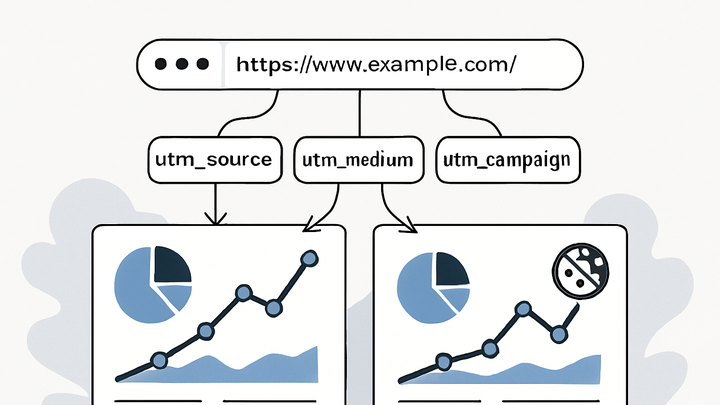Published on 2025-06-28T02:14:28Z
What Are UTM Parameters? Examples and Use Cases
UTM (Urchin Tracking Module) parameters are query string parameters appended to URLs to help track the performance of marketing campaigns across different channels. By adding UTM parameters like utm_source, utm_medium, and utm_campaign to your links, you provide analytics platforms with detailed attribution data. These parameters work seamlessly with both cookie-based tools like Google Analytics 4 and modern, cookie-free solutions such as PlainSignal. Proper use of UTM parameters enables accurate measurement of traffic sources, campaign effectiveness, and user behavior post-click. Without them, much of your marketing data would be lumped under generic categories like ‘Direct’ or ‘Referral’, obscuring the true impact of each channel. In this article, we will explore each UTM parameter, best practices for tagging, and examples of implementation in GA4 and PlainSignal.
Utm parameters
Tags appended to URLs to track and attribute campaign source, medium, and performance in analytics platforms.
What Are UTM Parameters?
UTM parameters, short for Urchin Tracking Module parameters, are snippets of text added to URLs to help track the source and performance of your marketing campaigns. Each UTM parameter consists of a key and value pair appended to the URL as query parameters. The five standard UTM parameters are utm_source, utm_medium, utm_campaign, utm_term, and utm_content. These parameters allow analytics tools to attribute website traffic to specific campaigns, channels, or content. They are supported by both traditional cookie-based platforms like Google Analytics 4 and modern cookie-free solutions like PlainSignal.
-
Utm_source
Identifies the referral source driving traffic (e.g.,
newsletter,google,facebook). -
Utm_medium
Specifies the marketing medium used (e.g.,
email,cpc,social). -
Utm_campaign
Names the specific campaign or promotion (e.g.,
spring_sale). -
Utm_term
Tracks paid search keywords (e.g.,
running+shoes). -
Utm_content
Differentiates similar content or links within the same campaign (e.g.,
header_link,footer_button).
Why Use UTM Parameters?
UTM parameters are essential for accurate campaign attribution, helping marketers understand which channels and strategies drive the most engagement. By tagging URLs with UTM parameters, you can compare the performance of different mediums, fine-tune messaging, and allocate budgets more effectively. They also enable you to analyze user behavior post-click across various analytics platforms. Without proper tagging, traffic sources can appear as ‘Direct’ or ‘Referral’, obscuring the true origin of visits.
-
Accurate attribution
Helps determine the exact source and medium of your website traffic.
-
Campaign performance analysis
Allows granular reporting on campaign effectiveness and ROI.
-
Channel comparison
Facilitates side-by-side evaluation of different marketing channels.
How to Implement UTM Tracking
Learn how to add UTM parameters to your URLs and integrate them with popular analytics platforms like GA4 and PlainSignal for accurate campaign measurement.
-
Manual url tagging
You can manually append UTM parameters to any link by adding query string parameters in the format
?utm_key=value&.... -
Google analytics 4 (GA4) integration
GA4 automatically captures UTM parameters once they are present in the URL. Ensure the GA4 tag is correctly implemented on your site.
-
Sample utm url
https://www.example.com/?utm_source=newsletter&utm_medium=email&utm_campaign=spring_sale&utm_term=50_off&utm_content=button -
GA4 tag snippet
<!-- GA4 Configuration --> <script async src="https://www.googletagmanager.com/gtag/js?id=G-XXXXXXXXXX"></script> <script> window.dataLayer = window.dataLayer || []; function gtag(){dataLayer.push(arguments);} gtag('js', new Date()); gtag('config', 'G-XXXXXXXXXX'); </script>
-
-
PlainSignal cookie-free analytics integration
PlainSignal provides simple, privacy-friendly analytics that also respects UTM parameters. Add the PlainSignal script to your pages to start tracking.
-
PlainSignal script
<link rel="preconnect" href="//eu.plainsignal.com/" crossorigin /> <script defer data-do="yourwebsitedomain.com" data-id="0GQV1xmtzQQ" data-api="//eu.plainsignal.com" src="//cdn.plainsignal.com/plainsignal-min.js"></script> -
Sample utm url
https://www.example.com/?utm_source=social&utm_medium=twitter&utm_campaign=product_launch&utm_content=card
-
Best Practices
Follow these guidelines to ensure your UTM tracking is consistent, accurate, and easy to interpret.
-
Consistency
Use a consistent naming convention across all campaigns to avoid data fragmentation in your reports.
-
Lowercase and hyphens
Stick to lowercase letters and hyphens (e.g.,
email-newsletter) to prevent duplicate tags due to case sensitivity. -
Descriptive values
Choose clear, descriptive parameter values that convey meaningful information about the campaign, medium, or content.
-
Avoid special characters
Refrain from using spaces or special characters; use URL-friendly characters only to ensure link integrity.
Analyzing UTM Data
After implementing UTM parameters, use your analytics platforms to review and optimize campaign performance based on the collected data.
-
GA4 campaign reports
In GA4, navigate to Reports > Acquisition > Traffic acquisition. Use the ‘Session campaign’ dimension to view UTM data for source, medium, and campaign.
-
PlainSignal utm reports
In PlainSignal, go to the Campaigns section to filter and visualize traffic by UTM parameters without relying on cookies.
